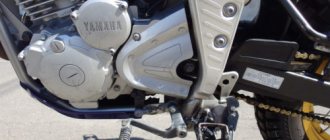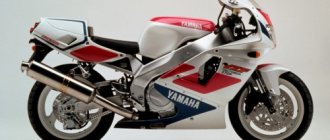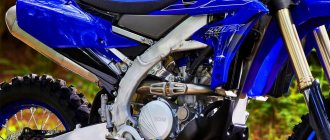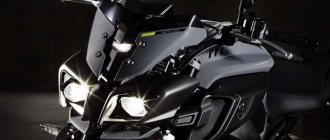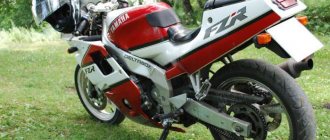| Yamaha WR250F (2001-2002) | Yamaha WR250F (2003-2004) | Yamaha WR250F (2005-2006) | Yamaha WR250F (2007-2010) |
| Yamaha WR250F (2011-2014) | Yamaha WR250F (2015-2017) | Yamaha WR250F (2018-2021) | Yamaha WR250F (2022+) |
| Yamaha WR250R (2007-2009) | Yamaha WR250R (2010-2020) | Yamaha WR250X (2007-2017) |
Yamaha WR 250 off-road motorcycle series
appeared on the market in 2001 with the
Yamaha WR250F
. The motorcycle was built on the basis of the motocross version of the Yamaha YZ250F, differing from it in the presence of headlights, suspension settings, engine and gearbox, exhaust, and larger radiators.
In 2007, the Yamaha WR250F model received an aluminum frame, and the WR250 series itself was replenished with two more models - the Yamaha WR250R
(soft enduro) and
Yamaha WR250X
(motard). The new versions are built on the basis of the WR250F, but differ in the settings of the suspension, engine (deformed, has 4 valves), the presence of an injection power system, 6-speed gearbox, etc. The motard version of the WR250X differs from the soft enduro WR250R in having 17′ road wheels, larger the diameter of the front brake disc (298 mm versus 250 mm), suspension settings (slightly reduced travel, increased rigidity) and chassis geometry.
By 2015, the hard enduro modification of the Yamaha WR250F receives serious updates - a new 4-valve engine with a higher compression ratio (13.5 versus 12.5:1), an injection power system, a new TCI transistor ignition, a 6-speed gearbox.
2017 marked the final year of production for the Yamaha WR250X version, while enduro variants are still being produced and sold in the European and North American markets.
At the end of 2021, Yamaha introduced the new generation Yamaha WR250F
. The model received a new frame, a new engine (the compression ratio was increased, the shape of the camshafts was changed, the cylinder head intake ports were modified, the gearbox settings were changed), a new brake system (the front disc diameter increased to 270 mm) and a new display.
Main competitors of Yamaha WR250 motorcycles:
- Honda CRF250X
- Honda CRF250L (250M)
- Kawasaki KLX250 / Kawasaki D-Tracker 250 / KX250X
001_MOTO_0310_032
Yamaha WR250R, enduro, 2009, 249 cm3, 30.7 hp, 134 kg, RUB 339,700.
Yamaha WR250R, enduro, 2009, 249 cm3, 30.7 hp, 134 kg, RUB 339,700.
NOT ACCORDING TO PLAN. If you want to make God laugh, tell him about your plans, says a famous proverb. We planned the Yamaha WR250R test for the beginning of December, remembering that in recent years snow has not fallen in the middle zone any earlier. In addition, I wanted not only to ride, but also to take part in the annual “Connecting Bear” rally, held by the Yaroslavl MS “Black Bears” (“Moto”, No. 2–2010). “There will definitely be a lot of snow in Yarik, but it’s still noticeably north of the capital,” I thought, taking out my winter gear from the mezzanine. Nature turned out to be much more inventive in terms of jokes on me, naive. Just before the start of the test, snow began to fall in Moscow and the surrounding area, and even the shooting turned out to be quite wintery. As for the test itself near Yaroslavl, the height of the snow cover mockingly melted in proportion to the approach to the starting point. Well, quite seasonal “minus eight” with an invigorating breeze, firmly frozen ground, ice in puddles and an almost complete absence of snow. You can’t imagine anything worse - the dirt is already frozen and is as hard as asphalt, slippery, like on a skating rink, and there is no soft snow in which you could “land” softly and pleasantly. But you will have to hit it. The Michelin Cross Competition S12 cross-country tires, although toothy, are not at all designed for driving on ice: the already hard tire, having become quite hard in the cold, behaved like slicks, so by the end of the route I could be diagnosed with “a bruise of the whole grandma” " But we’re not testing me, but a motorcycle, so we’ll turn to that.
Brief history of the model
- 2001 - start of production and sales of Yamaha WR250F.
Model
: Yamaha WR250F (Europe, North America, Oceania, etc.).
Factory designation
: 5PH1, 5PH2, 5PH1, WR250FN (USA).
- 2002 - no significant changes.
Model
: Yamaha WR250F (Europe, North America, Oceania, etc.).
Factory designation
: 5PH5, 5PH6, 5PH8, WR250FP (USA).
- 2003 - no significant changes.
Model
: Yamaha WR250F (Europe, North America, Oceania, etc.).
Factory designation
: 5UM1, 5UM2, 5UM4, WR250FR (USA).
- 2004 - no significant changes.
Model
: Yamaha WR250F (Europe, North America, Oceania, etc.).
Factory designation
: 5UM5, 5UM6, 5UM7, WR250FS (USA).
- 2005 - the diameter of the front fork increases to 48 mm.
Model
: Yamaha WR250F (Europe, North America, Oceania, etc.).
Factory designation
: 5UM8, 5UM9, 5UMA, WR250FT (USA).
- 2006 - The WR250F gains a digital instrument cluster.
Model
: Yamaha WR250F (Europe, North America, Oceania, etc.).
Factory designation
: 5UMB, 5UMC, 5UMD, WR250FV (USA).
- 2007 - The WR250F gains an aluminum frame. The appearance of modifications WR250R and WR250X.
Model
: Yamaha WR250F;
Yamaha WR250R; Yamaha WR250X (all markets). Factory designation
: 5UME, 5UMF, 5UMG, WR250FW (USA); 3D71 (Japan); 3D72 (Japan).
- 2008 - no significant changes.
Model
: Yamaha WR250F;
Yamaha WR250R; Yamaha WR250X (all markets). Factory designation
: 5UML (Europe), WR250FX (USA); WR25RXCL (USA), 32D1, 32D3, 32C5; WR25XXCL (USA), 32D4 (Australia), 32D2 (Europe).
- 2009 - no significant changes.
Model
: Yamaha WR250F;
Yamaha WR250R; Yamaha WR250X (all markets). Factory designation
: 5UMP, 5UMR, 5UMS, WR250FY (USA); WR25RYL (USA), 3D73, 32CB, 32D5; WR25XYB (USA), 3D74 (Japan), 32D6 (Europe).
- 2010 - Yamaha WR250R and Yamaha WR250X models receive new suspensions - KYB inverted forks and Soqi adjustable monoshock.
Model
: Yamaha WR250F;
Yamaha WR250R; Yamaha WR250X (all markets). Factory designation
: 5UMU, 5UMV; WR25RZL (USA), 3D75, 32DB, 32CH; 32DC, 32CJ, 3D76.
- 2011 - no significant changes.
Model
: Yamaha WR250F;
Yamaha WR250R; Yamaha WR250X (Europe, North America, Japan). Factory designation
: WR250FA (USA), 1HC2, 1HC3; WR25RAL (USA), 32DF, 32CP, 3D77; WR25XAW (USA), 32CR, 3D78.
- 2012 - no significant changes.
Model
: Yamaha WR250F;
Yamaha WR250R; Yamaha WR250X (Europe, North America, Japan). Factory designation
: WR250FB (USA), 1HC6, 1HC7; WR25RBL (USA), 3D79, 32DH, 32CW; 32DJ, 3D7A.
- 2013 - no significant changes.
Model
: Yamaha WR250F;
Yamaha WR250R (Europe, North America, Japan). Factory designation
: WR250FD (USA), 1HCA, 1HCB; WR25RD (USA), 3D7B, 32DN, 2CF3.
- 2014 - no significant changes.
Model
: Yamaha WR250F;
Yamaha WR250R; Yamaha WR250X (Europe, North America, Japan). Factory designation
: 1HCD; WR25RE (USA), 3D7C, 32DT, 2CF6; 3D7D, 32DP.
- 2015 - Yamaha WR250F model receives a new 4-valve (instead of 5-valve) engine with an increased compression ratio (from 12.5 to 13.5), electronic fuel injection, transistor ignition system, new adjustable KYB suspension and 6-speed Checkpoint.
Model
: Yamaha WR250F;
Yamaha WR250R (Europe, North America, Japan). Factory designation
: WR250FF, 2GB2, 2GB3; WR25RF (USA), 3D7E, 32DW, 2CF9.
- 2016 - no significant changes.
Model
: Yamaha WR250F;
Yamaha WR250R; Yamaha WR250X (Europe, North America, Japan). Factory designation
: WR250FG, 2GB6, 2GB7, 2GB8; WR25RG (USA), 3D7G, BN32, 2CFC; 3D7F.
- 2017 is the final year of production for the Yamaha WR250X.
Model
: Yamaha WR250F;
Yamaha WR250R; Yamaha WR250X (Europe, North America, Japan). Factory designation
: WR250FH, 2GBC, 2GBD; WR25RH (USA), 3D7H, 2CFF; 3D7J.
- 2018 - no significant changes.
Model
: Yamaha WR250F;
Yamaha WR250R (Europe, North America). Factory designation
: WR250FJ, 2GBG, 2GBH; WR250RJ.
- 2019 - no significant changes.
Model
: Yamaha WR250F;
Yamaha WR250R (Europe, North America). Factory designation
: WR250FK; WR250RK.
- 2020 - no significant changes.
Model
: Yamaha WR250F; Yamaha WR250R (Europe, North America, Australia).
- 2021 - no significant changes.
Model
: Yamaha WR250F (Europe, North America, Australia).
- 2022 - Yamaha WR250F restyling.
Model
: Yamaha WR250F (Europe, North America, Australia).
002_MOTO_0310_033
MAKE THE WAY TO THE YOUNG. At first glance, the WR is not much different from the now classic Iksers, Tters and other Deers, except that the design of the plastic is more modern. In reality, this “check” is much more serious. And, as usual, the main thing is not visible from the outside. Firstly, a diagonal aluminum alloy frame has finally arrived in the 250 class. Having already become familiar on cross-country equipment, it is in no hurry to retire the steel duplexes of dual-purpose motorcycles. (Like, who cares about a button accordion? There is an opinion that “for rides around the dacha” a super-stiff and light frame is useless. And iron is cheaper.) So WR is the exception rather than the rule, but, looking ahead, I will say that The exception is very pleasant and useful.
Probably the only full-fledged competitor to the WR250R is the KTM 250 EXC-F, and even then, once you look under the plastic, the “Austrian” disappears into the shadow of its Japanese counterpart: the most important difference between the WR and all its peers is the fuel injection system. Perhaps for the first time in the world, Yamaha approached the design of a 250 cc “endurance” not as a “budget moped for beginners”, but as a serious device. In addition to a frame made using cross-country technology (the design is borrowed from the YZ series) and a fuel injection system, the motorcycle is equipped with a catalytic converter, a full set of lighting equipment, a dashboard with a large LCD monitor and even passenger footpegs. All this makes it not only the most advanced in its class, but also suitable for driving on public roads (by the way, it is the only one in the line of Yamaha SUVs officially supplied to Russia). At the same time, the equipped device does not weigh that much - 134 kg. Of course, a purely sporty WR450 will be lighter, but in comparison with its classmates - take the same "Baja" - the difference of 10 kilos is not so great. Moreover, if the goal is to lighten the device, even a simple replacement of the “can”, in which, in addition to the muffler, a neutralizer is also installed, with a tuning one will almost immediately eliminate this difference. The only thing that upset me was the lack of a kickstarter. A device that claims to be a serious conqueror of the “pampas” is without it. It seems clear that an injection engine cannot be started with a “dead” battery, but there are batteryless injection systems in motocross, right? If they made the device “with all the money”, why did they save? Unclear.
The motorcycle was very successfully purchased with a mileage of only 700 km, at a very reasonable price. After riding, I realized that for my purposes it was enough, but there was no limit to perfection, and it was decided to subject the motorcycle to some improvement. Stage one: First of all, all sorts of unnecessary parts were removed from the motorcycle, such as: - plate for attaching the number plate. (Why is there a number plate in the forest?) - trunk. (operation in tourist mode was not particularly implied) - passenger footrests. (no comments)
Which allowed me to lose about 2 kg of really EXTRA weight.
Then all sorts of different protection was installed on it: - radiator protection from MOOSE RACING
-protection of hands/controls from the same MOOSE RACING
-plastic underbody protection (also MOOSE RACING)
After this, the motorcycle wheels were modified: -tyres, instead of the stock Pirelli for universal use, a set from Shinko HOLE SHOT was supplied, for soft ground, since the motorcycle was meant to be used mainly in the forests of the Moscow region, where even in the driest summer there is enough dirt, with this From the same point of view, the maximum possible tire width was set, instead of the standard 120/80-18 there was 120/100-18, and the front tire instead of 80/70-21 was 90/90-21.
Along with the new rubber, reinforced tubes with a wall thickness of 3 mm were installed in order to minimize the possibility of punctures and breakdowns when operating at low pressure, and shoes were installed to avoid turning the tires relative to the rim and tearing off the nipple from the tube. All together allows you to operate the motorcycle at extremely low tire pressure, about 0.6 ATM, and successfully move on very soft soils, even to swamps...
In addition, the standard soft and heavy steel steering wheel was replaced with a durable and lightweight aluminum Renthal, which saved some weight and added strength.
The standard drive sprocket cover, under which dirt constantly accumulated, was replaced with a tuning grille, which allows this unit to be washed normally without removal. And the final touch of the first stage of tuning were valves to relieve excess air pressure in the fork. The fact is that due to the design of the fork, during operation it absorbs air, which acts like a spring and negatively affects the work. This air must be released periodically. Normally this is done through special screws in the upper covers of the fork legs, using a screwdriver. Valves screwed in instead of these screws allow this to be done with the pressure of a finger. Which is more convenient and faster. A small nuance: when bleeding air, the front wheel of the motorcycle should hang in the air.
At this point, the first stage of tuning was completed, and the motorcycle existed in this form for about a year. And then came Phase Two.
The main disadvantage of this motorcycle, in my opinion, is the weight. In stock it weighed 134 kg of total weight, after the first phase of tuning the weight practically did not change, because in replacement of what was removed, a bunch of protection, thick inner tubes, wider tires, and so on were installed. Therefore, it was decided to carry out further tuning in the direction of making the motorcycle even lighter. And the first thing in line was the gas tank. It’s not clear why, but the manufacturer decided to equip this car with a steel gas tank, although the Yamaha WR250F (the more evil, “combat” version) has been sporting plastic for more than one year...
Thus, the standard 7.5-liter gas tank was removed and its place was taken by the IMS 3.0 Gal Fuel Tank. I don’t have exact figures for weight savings with this replacement, but it feels like a steel tank WITHOUT a fuel pump weighs more, several hundred grams, than a plastic tank with a fuel pump. I would venture to guess that the weight savings amounted to one and a half kilograms, which is not bad at all. Well, at the same time, the volume of fuel on board increased from 7.5 liters to 11.36 liters... In principle, during current operation, such a volume is not really needed, but, firstly, no one forces you to fill the tank full, and secondly, even with a full tank, the weight turns out to be approximately the same as it was with the old full tank, only here the iron together is useful gasoline, which, for example, can save your ride buddies from drying out. There are thoughts about installing an external fuel tap for this purpose. The only time you feel the weight of the extra gasoline is when you lift the motorcycle with a full tank from the ground...
The next candidate for replacement after the gas tank was the standard steel and heavy-duty muffler. It was decided to replace it with Leo Vince X-3, saving about 1.5 kg in weight. In addition, it turned out that by replacing the muffler, you can carry out a certain set of measures and increase the power of the motorcycle by about 15%, which is about 4-5 horses, which is not at all superfluous.
There was only one hitch in the operation of replacing the muffler: the lambda probe categorically did not want to leave the old muffler, and we had to tinker with its rearrangement using heavy artillery in the form of a vice, a sledgehammer, a one and a half meter pipe, a construction hair dryer and WD40. As a result, although with minor damage to the thread, it was successfully installed in the new muffler...
This completed phase two. But there is no limit to perfection, so Phase Three awaits us next.
During the muffler removal process, components of the EXUP system were partially removed. This system consists of a spring-loaded damper in the muffler, a servomotor that controls this damper, and drive cables with jackets. It all looks like this: and weighs about 0.7 kg. The main problem when removing this system is that the on-board computer gives an error and lights up the CheckEngine lamp when the drive is disconnected. Here you can go in two or even three ways: 1. disconnect the cables from the servomotor and leave it in place (and carry with you an extra 600 grams and one electricity consumer) 2. you can put a “plug” in its place and deceive the computer. (in my case it’s ESRM-1 from dynojet) 3. You can traditionally plug a 7.5 ohm resistor between two specific pins in the power supply/servomotor control wire and also deceive the computer. As it turned out later, this is the cheapest, most effective and trouble-free remedy...
However, I took the second path and plugged in a plug from Dynojet (I wanted Feng Shui, beauty and a minimum of collective farm, how wrong I was):
Everything turned out to be not as simple and joyful as the manufacturer promised... The CheckEngine lamp did not light up right away, but after 5-10 minutes of engine operation, the lamp did come on and display error 17 “servomotor jammed.” To eliminate the error, I had to disassemble the motor, remove the plug, attach the motor, turn on the motor, the error disappeared, turn off the motor, put the plug back, after which after 5-10 minutes of operation the situation repeated itself. After corresponding with Dynojet Research support, I was asked to “slightly modernize” the module by removing a certain pin from it, which I did. The module was installed and the situation seemed to return to normal... however, the motor continued to occasionally blink the CheckEngine lamp. And, after a couple of days of use, after falling on its side, the lamp came on again with the same error (servomotor jamming). I freaked out, tore off another pin... and voila! Miracle! everything worked, without any errors or glitches! =) 2. Removing the AIS system The system includes: an air supply pump, a rubber pipe from the pump to the airbox and a steel pipe from the pump to the exhaust manifold. To remove the system, it is necessary to plug the inlet port in the exhaust manifold and the outlet port of the air filter. For these purposes, there is even a special kit consisting of an aluminum plate with holes and a rubber blind pipe. In the end, I turned the plate myself, using a saw and file, and sealed the airbox with a bolt and electrical tape. The collective farm rules. The AIS system at a glance weighs about 500 grams, which when combined with EXUP gives us more than a kilogram of weight removed from the motorcycle and almost free of charge. 3.removing the air intake control system into the air filter. The system consists of a vacuum pump, a vacuum damper drive, some unknown damn thing and hoses connecting it all; let’s face it, all these tops weigh about 300 grams. And it interferes somewhat with the engine. This is where the work on removing/installing spare parts ended. The final touch is some enrichment of the mixture using the standard on-board computer. The fact is that the on-board computer of the WR250R allows you to manually adjust various parameters, including the mixture enrichment indicator, after entering it into the diagnostic mode, and allows you to do this “on the fly” while driving. Which is very convenient for setup. As a result of the tuning, a weight saving of around 6 kg was obtained; a huge amount of all unnecessary hardware and equipment was removed from the motorcycle.
The engine power has been slightly increased, approximately from 30.7 stock to 35-36 horsepower. (If you believe the bourgeoisie who took measurements at the stand after this tuning). And the fuel supply on board has been increased. And for dessert, 3 teeth were added to the driven sprocket (it became 46 as opposed to the standard 43), which slightly shifted the torque down and greatly added comfort when driving through the forest.
For now, tuning has been suspended, but there are already thoughts about replacing the head optics with a diode headlight for an ATV, replacing turn signals, and so on and so forth...
003_MOTO_0310_034
CONNECTING ROD DRIVE. The first WR test awaited early Saturday morning. How will the injection engine perform after spending the night in an “open field” with strong frost? Is it easy to start compared to Xers and Jebels? Several startup attempts led to nothing. The fuel pump made a sound like the buzzing of a dying fly, the starter sluggishly cranked the crankshaft several times, and WR took his place in line to “light up” the car. Having gained access to the required volts, the engine started instantly, unlike its “colleagues” with frozen carburetors. The fly in the ointment, however, turned out to be smaller than it seemed. The next morning, after another overnight stay “in the field,” the motorcycle started up on its own—it was due to a dead battery. Like any injection technology, WR requires special attention to the condition of the battery. I already mentioned the vicissitudes of fate, weather and unsuitable tires, so the next highlight of the winter test program was checking for “startability” after falls. Each carburetor “endurance” has its own characteristics: the Djebel cannot be “put” on its left side, the XR generally bleeds gasoline from the drainage pipes every time it falls and then comes to its senses for quite a long time before starting, the KTM 450 must be laid on its right side in order to the gasoline flowed “where it should”... In a word, it’s not very pleasant, especially when the group you’re traveling with has “turned off its brain, turned on the gas and is throwing all its money away.” What about competitions?.. WR showed himself to be excellent in this discipline. I can’t count how many times I had to “fly off” during this frostbitten test, but each time the engine instantly came to life as soon as I touched the starter button. The injection does its job - the engine will start even upside down!
004_MOTO_0310_034
The instrument panel is easy to read even under bright sun and displays a lot of useful data.
The instrument panel is easy to read even under bright sun and displays a lot of useful data.
An easy start is far from the main advantage of an injection engine. The main thing, in simple terms, is “how it drives.” And let me tell you, he’s going just fine! The first thing that really struck me was the juicy thrust from the lowest revs. The motorcycle is confidently “lucky” almost from idle, compared to “carbureted” copies, which need to “spin up” quite a bit in order to produce any traction. Even the generally recognized leader of the class in terms of torque, the Honda XR, “leaks” the WR by a huge margin. The good news is that throughout the entire rev range you can hardly feel any dips or catches. And although the peak torque value is even lower than that of the Xer (23.7 Nm at 8000 rpm versus 25 Nm at 7000 rpm), it is spread over the revolutions in such an even and thick layer that the feeling is the opposite.
005_MOTO_0310_034
“Remotes” are made according to classical canons.
“Remotes” are made according to classical canons.
Unlike many fuel-injected motorcycles, the WR responds to the gas instantly and very accurately, there is no hesitation at all. Turning the handle is a pleasure. The feeling of the good old variable vacuum carburetor does not leave you for a minute, and this is, perhaps, one of the main factors for both the accuracy of thrust dosing and the notorious fan factor. It's nice to feel that the device is completely under control.
Yamaha WR250F Suspensions
The Yamaha WR250F is equipped with the same suspension as the YZ250F: KYB Speed Sensitive System (SSS) spring fork and KYB shock absorber, but with different valving and spring settings selected for enduro. The fork and rear shock travel are 31 and 31.7 cm, respectively. The fork has compression and rebound adjustments, and the shock absorber has a spring preload adjuster, separate adjustment for fast and slow compression, and rebound.
On the road, the WR250F is incredibly comfortable. Compared to the cross-country version, the suspensions are tuned much softer, but perfectly resist breakdown. The fork resists folding under braking quite well, so it gives confidence for tougher turns. At the beginning of the strokes, the suspensions are very soft, but they allow you to ride over rocks comfortably. The shock absorber is perfectly balanced relative to the fork.
006_MOTO_0310_034
Nothing extra, just ergonomics.
Nothing extra, just ergonomics.
The frozen ruts of dirt and forest paths are not the most pleasant place for rides, but is it possible to think of something more suitable for testing the chassis? You will probably not find hard potholes in such quantities and in such variety anywhere except in the rocky mountains. Longitudinal and transverse ruts, holes, fallen trees frozen in the Central Russian slurry - in a word, not a single soft “folk-national” enduronic obstacle! It's time to say thank you to the oak Cross Competition tires. If on flat areas they slide shamelessly, then here hard checkers cling perfectly to the petrified terrain, allowing you not to worry too much even when crossing ruts from a “shishiga” (GAZ-66) at an acute angle. But the merit of this is not only the rubber. The rigidity of the chassis and the energy intensity of the suspension are truly impressive! Where the representatives of the “Big Three” (XR, DR, TT-R) would have long been prancing around in the “flying low over the pampas” pose, the WR allows you not even to get out of the saddle! At first, when overcoming the longitudinal ditches, I was afraid that the frame was about to “play”, bent like a screw, and the next crossing of the obstacle would end in the nearest bushes, but the Yamaha swallowed them like a cigarette butt thrown by someone on the asphalt. To be honest, I couldn’t feel the chassis moving even on the trickiest gullies. Still, cross-over technologies were really introduced here for a reason.
007_MOTO_0310_034
Passenger footpegs are an “extra” detail for a hard enduro, but valuable for a road motorcycle.
Passenger footpegs are an “extra” detail for a hard enduro, but valuable for a road motorcycle.
FOR SWEET. The route of the “Connecting Bear” rally is a little less than 100 km of complete off-road. In general, it can be described in one single word: “tough”. And not because it turned out to be difficult, on the contrary, in a place where you could have wallowed in the mud to your heart’s content (if the weather had been warm, like last year) or got stuck up to your ears in snowdrifts (like the year before), it would have been much more difficult and more interesting. It’s just very painful to fall on the frozen ground, not only for the pilot, but also for the motorcycle.
Reviews from real owners about Yamaha WR250R and Kawasaki KLX250S motorcycles
As I have said many times in the article on choosing a first motorcycle, these are perhaps the best choice for a beginner. They are comfortable, reliable, passable, and powerful enough for both off-road and city use. The Yamaha WR250R, as well as the Kawasaki KLX250S, were the first motorcycles of my good friends. Each of the guys remembers their first horses with warmth. Over several years of operation, absolutely no breakdowns. Just a scheduled oil change and that's it. Of course, over time, the capabilities of these motorcycles ceased to be enough, and therefore the guys, having ridden them for several years, understood what they wanted from an enduro. Their choice was hard enduro and the second motorcycles the guys bought were Europeans. Some people, on the contrary, get involved in traveling and buy larger tourenduros. Well, as for our reviewers, these are the most versatile motorcycles for a variety of tasks. On them you can quite feel what enduro is, what motorcycle tourism is, and what a comfortable motorcycle for the city is.
009_MOTO_0310_034
The quick-release “tail” with license plate fastening is a newfangled and very useful feature.
The quick-release “tail” with license plate fastening is a newfangled and very useful feature.
And even though the linings are made of “soft” plastic, frost does its job and the plastic becomes fragile. I managed to split one of the linings. But, I’ll give the company credit - no plastic would withstand such conditions! So I won’t write this “joint” down as a minus. The motorcycle came out of this battle, although wounded, but a winner. And the gear shift paw, bent in one of the falls, was easily returned to its original shape with a light blow from the motorboat. Moreover, judging by her behavior, she is capable of withstanding quite a few such executions - that’s what correctly selected material means. The only tuning required on any off-road motorcycle is to protect the levers. Without it, there is usually enough leverage for exactly two falls - on the right and left sides, especially if the ground is hard. WR, unfortunately, was not equipped with such an option. At the finish line, I showed my front brake lever to my friends, and they shook their heads approvingly: tied literally in a knot, it still did not break, although it took the weight of the motorcycle not five or ten times.
008_MOTO_0310_034
Conventional brakes by class standards - both in design and efficiency.
Conventional brakes by class standards - both in design and efficiency.
It turns out that it’s just a perfect motorcycle - everything about it is so wonderful. An involuntary comparison with the “Big Three” is probably in many ways inappropriate; after all, the difference in the age of the models is more than 10 years. But if you turn your attention to the market, everything falls into place. The same “Xers” from recent years of production (2006–2008) cost 230 thousand rubles, or even more. Is a motorcycle designed twenty years ago worth the money? Maybe yes. He deserved it. But the icons of the past deserve respect and honor, and the way goes to the young! In my opinion, the WR250R beats any of the heroes of the past by 10 points in any parameter. And if you set a goal and slightly modify it, change the exhaust, install a tuning “brain”, “saw off” not very necessary bells and whistles, like the “tail” for the license plate and passenger footrests, and make some other well-known changes, from a modest motorcycle "dual purpose" you can build a real fighting mustang. Fierce but obedient!
Terms of purchase for our clients
You will find the best offer for purchasing a Yamaha WR250 motorcycle on our website. Extensive experience in the motorcycle market will allow us to help clients solve problems of any level of complexity, find the best economic and technical solutions, analyze the necessary characteristics and make the right choice. We are ready:
• arrange delivery of Yamaha equipment directly from Japan; • choose the best transportation options and routes; • guarantee the high quality of motor vehicles and their compliance with established standards; • help in choosing suspension, year of manufacture and other equipment parameters; • organize customs clearance of cargo and complete other formalities.
Cooperating with us is convenient and profitable, as numerous clients who have placed orders on the Cemeco.ru website have already been able to verify. We offer to order equipment from well-known manufacturers at retail, and also actively work with wholesale buyers from different cities of the Russian Federation. Completing an application on the website takes just a few minutes. Contact our managers and we will do everything possible to promptly complete any order.

